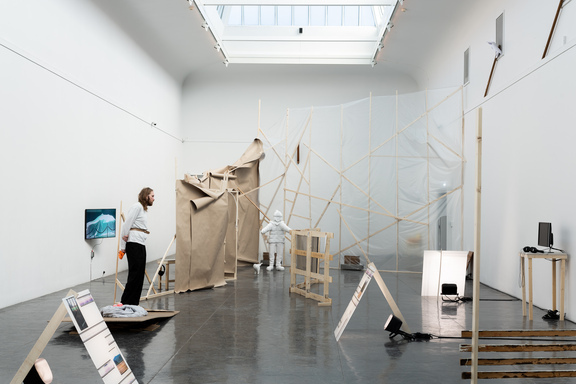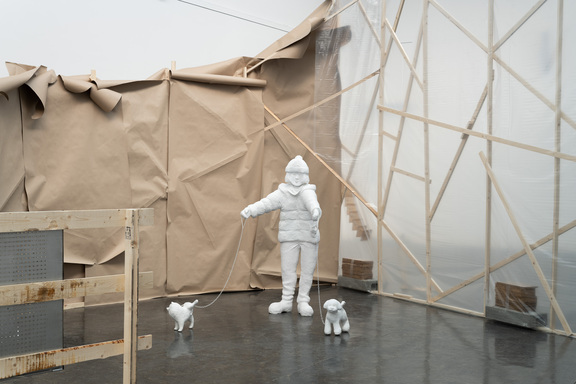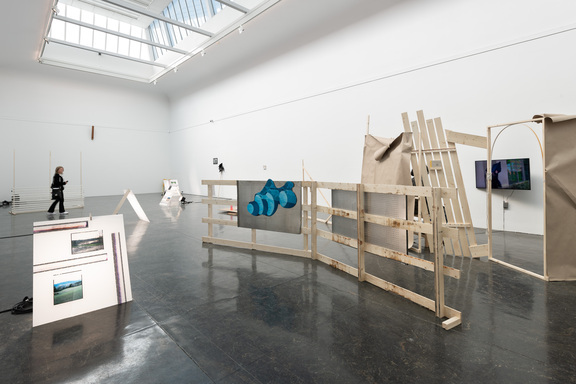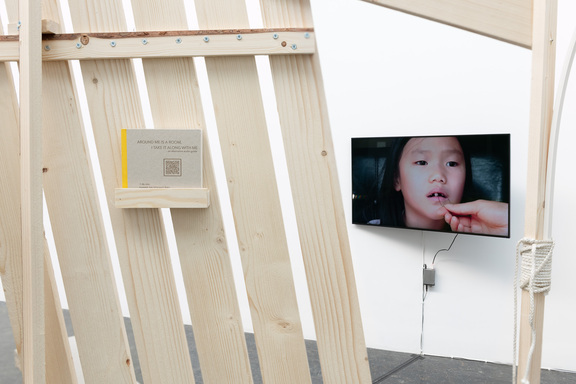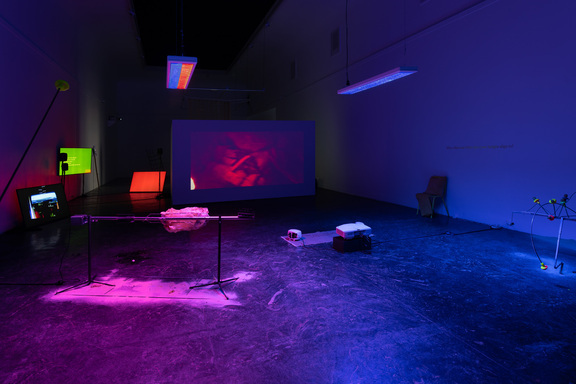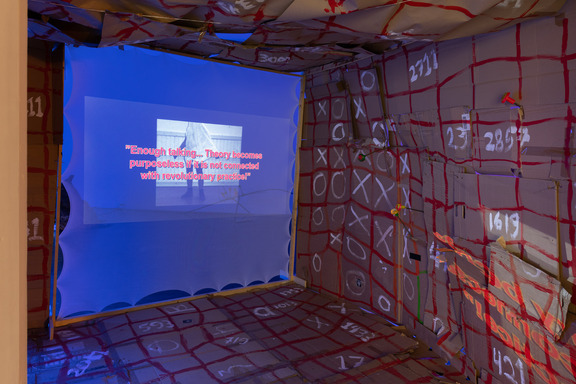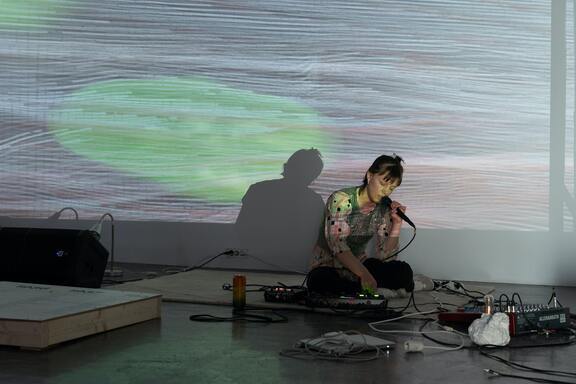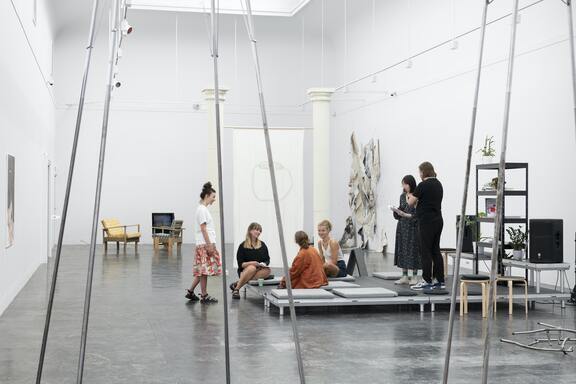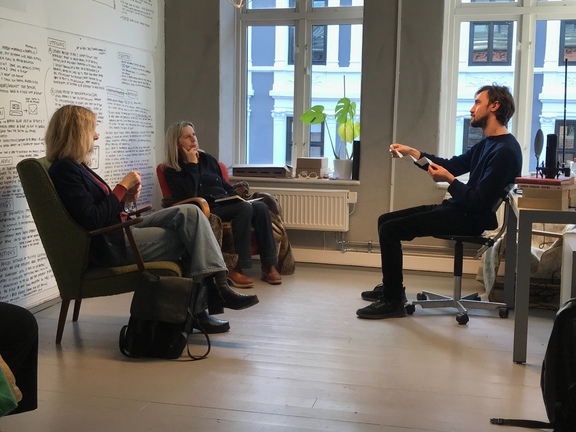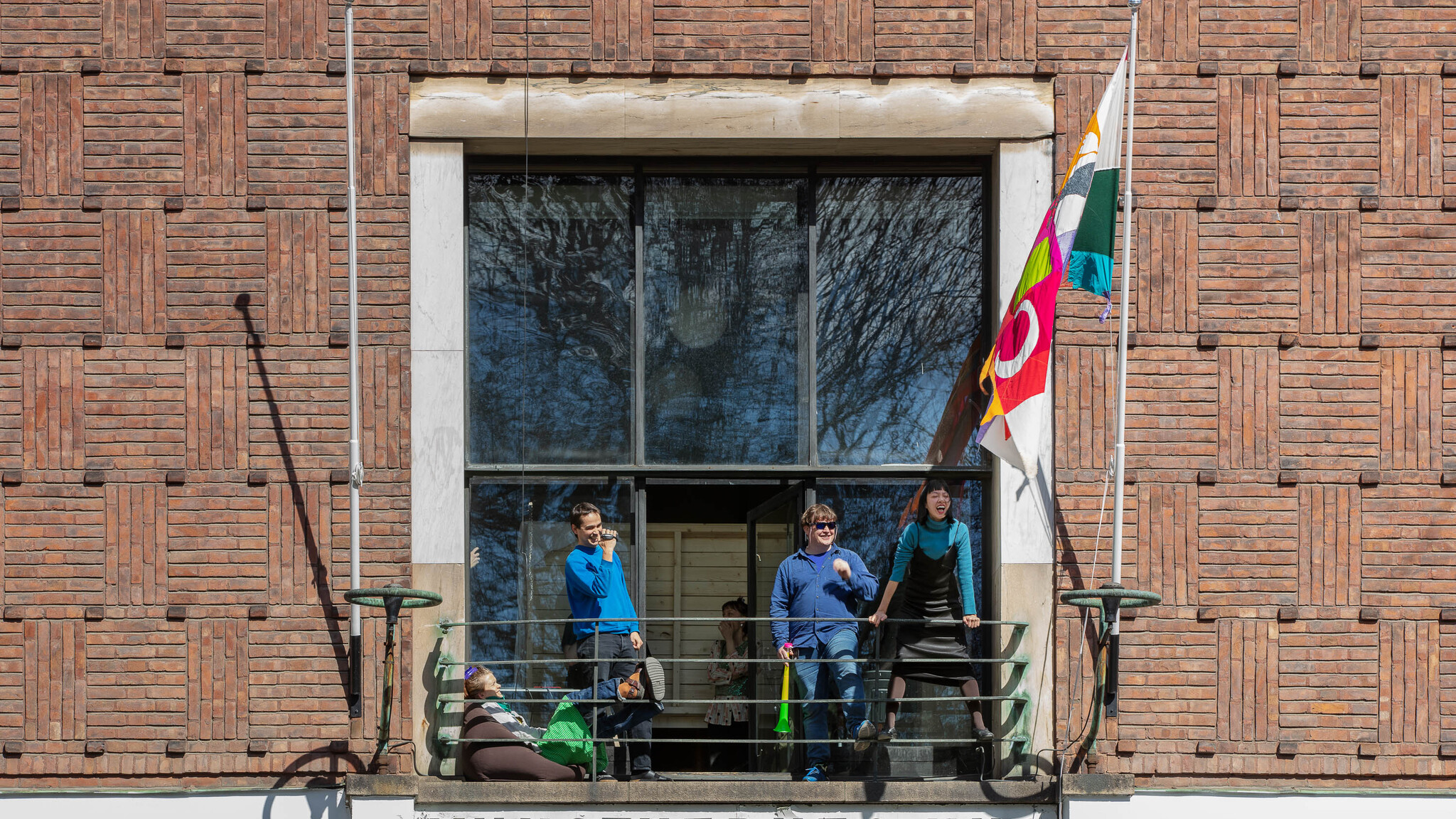

Master’s in fine art (MFA)
The Master of Fine Arts (MFA) is a two-year degree programme (120 ECTS) aiming to offer students the knowledge required to become an independent artist. The MFA enables students to become active contributors within contemporary art and related areas of society, and aims to prepare fine-art professionals for a national- and international-level practice.
The guiding principle of the Academy is close and regular engagement with an internationally renowned faculty of artists, theorists and curators, and a diverse group of students. The programme aims to foster a reflective approach to the artist’s individual practice, as well as to provide contextualisation, dialogue and critical feedback in a dynamic and inclusive environment.
The first year of the programme is structured by a shared course tying critical discourse to the student’s artistic processes and the choices we are confronted with when exhibiting. The second year builds on the learning and experimentation of the first year and includes a thorough focus on a graduating solo presentation, a group project - as well as life beyond the academy as a practicing artist.
The Master’s programme welcomes students who wish to work in an interdisciplinary, non-medium-specific context as well as those who wish to pursue a particular discipline. We encourage students to participate actively in collaborations with other institutions and art circles. Students are expected to adopt an international perspective and to work on building networks during their studies. Speaking and writing skills are an important aspect of the education, with significant emphasis placed on cultivating research skills, as well as exploring different ways of framing your practice for others. In the second year, the student will produce a research paper rooted in their practice, as well as a text to accompany their graduation exhibition.
There are four strands to the Master’s programme:
- independent practice, with a focus on studio work via individual supervision and group critique
- practical seminars/workshops, including courses and study trips addressing various themes
- theoretical seminars on a variety of topics, learning a critical vocabulary around the student’s own practice
- exhibition practice in the school’s galleries and external spaces
Curriculum
Brief Programme Description
The programme offers teaching at the highest level in contemporary art on a variety of contemporary art practices, including painting, drawing, photography, video, film, sculpture, installation, performance and new media, etc.
The programme is interdisciplinary and not medium-specific.
The programme accommodates students who are not proficient in Norwegian, and all courses can, if necessary, be taught in English.
Admission Requirements
Admission to the Master’s programme requires a three-year degree in fine art (Bachelor’s degree of 180 ECTS credits or equivalent). The first degree must include specialisation in a subject, course or course group of at least 80 ECTS credits within the discipline of the Master’s programme.
The following criteria will be prioritised:
- independent practice and artistic research
- motivation
- suitability for the programme
- previous relevant experience
All applicants must document proficiency in English.
Learning Outcomes
Upon completing the programme, students should be able to
- conduct independent, high-level research into artistic questions, ideas or issues through experimentation and production
- study complex artistic or theoretical references and other relevant methods
- articulate artistic questions and issues that are relevant for developing their own and others’ practice
- analyse, contextualise and discuss their own and others’ works, including presenting, defending and articulating their work within a critical framework
- use informative and analytical methods to propose, articulate and reflect on different interpretations and critiques of artworks and ways of approaching artistic questions
- contextualise and discuss key concepts in cultural practice and theory
- develop networks for dialogue or collaboration with others on their own work and independent projects and research
- express their artistic questions in writing, employing a vocabulary suited to their practice
- understand experimental strategies as well as appropriate ways to present and disseminate writing practice
- produce a final research paper where they, in a reflective way, articulate questions and ideas that inform or shape their practice
- have a comprehensive understanding of different exhibition or presentation formats, including their histories, contexts and conventions
- present their own works in appropriate and varied forms of display, in collaboration with curators, fellow students or others
- communicate in visual, spatial and material ways in order to engage the viewer
Structure and Progression
At the core of the study programme are students’ work in the studio. Tutorials and group critiques support the development of the student’s individual practice. The programme is based on the understanding that contemporary art is closely linked to historical, social, political and cultural contexts.
Emphasis is therefore placed on analysing and contextualising artistic practice within a broad perspective, with a particular emphasis on art history, philosophy, anthropology, architecture, political theory, psychoanalysis as well as other disciplines and contexts that are part of the student’s own practice.
The programme offers approaches with references to the art field, but it also extends to other disciplines and encourages a critical discourse within the practices we teach.
Writing practice is a point of emphasis. With support from the Academy’s writing teachers and publishing facilities, we encourage students to develop their own voice and publish their own texts in a variety of formats.
The public dimension of the student’s practice is an important part of the programme. Students are encouraged to enter a dialogue with fellow practitioners, as well as various actors and spaces in the art field, in order to reflect on how their practice relates to modes of circulation. The programme includes public platforms such as exhibitions, the Open Academy, performances, events and lectures, and encourages students to participate and critically reflect on these formats and their content.
The programme is organised according to four course categories: Artistic Practice, Thematic Focus, Theory for Practice and Exhibition Practice.
Artistic Practice: Artistic practice is a central aspect of studying at the Academy of Fine Art. Students develop their thinking, artistic strategies and experiments, as well as produce works independently. This may involve technical instruction, artistic production, engaging in the works of other artists, reading literature and theory, archival research, fieldwork, collaborative and discursive practices, or any other type of activity that is relevant for the student’s questions and interests.
At the beginning of every academic year, each student is allocated, based on a system of student prioritization, a new main advisor among the Academy of Fine Art’s academic staff. The main advisor will oversee their development and provide continuity, and guide the student’s development and provide continuity through individual tutorials as well as through group critique sessions. The main advisor groups are a mix of students from the BA and the MA programme.
Central to the group critique sessions are formal presentations, critiques and analysis. Allowing students to have their works, artistic questions and intentions discussed by their fellow students, allows individual students to test out and reflect on the various interpretations generated by the works. These discussions may reveal connotations, implications, issues or solutions that the student has not yet considered, and they may also corroborate his or her artistic decisions. Group critique aims to develop the ability to both enter the work and to obtain a critical distance to it; that is, to assume the dual role of producer and external viewer. Further, the ability to interpret and discuss other artist’s works is crucial because it helps students to reflect on how their own works may be received in public space. By engaging in discussions about the works of others, students will also develop a critical vocabulary and tools to analyse and question artworks. Discussing other students’ works is an exercise in interpreting art, thinking aloud and reflecting on possible perspectives, approaches and solutions.
During the first year of the programme, the main emphasis will be on experimenting and exploring processes, ideas and the use of materials. By the end of the second semester, students must have completed one or more works that demonstrate their ability to incorporate both their own independent research as well as the critical perspectives of their main advisor and group critique peers, with an eye towards developing the student’s future production. During the second year of the programme, the emphasis will be on students developing and producing their graduation projects.
Thematic Focus: The Academy of Fine Art offers a wide range of thematic workshops, seminars and lectures 4 that aim to enhance the student’s practice, gain an understanding of the history and context that shape contemporary art, and experiment with new artistic strategies and materials.
Thematic Focus courses will to varying degrees relate ideas and topics to artistic production. Topics will often cut across different practices and discourses, potentially including technical specialisations, interdisciplinary practices and relevant social, political and cultural questions.
Theory for Practice: By engaging with theoretical and art historical approaches, Theory for Practice contributes to students development of a language and frame of mind that can support reflection on the work of oneself and others. These approaches can involve writing practice, but conversations are of equal importance. During their final year, students will write a research paper that enhances their ability to examine and contextualise their graduation project.
Exhibition Practice: Developing ways to present an artistic project in public spaces is a central part of any artist’s practice. The Academy of Fine Art offers a number of occasions where students may experiment with exhibition practices and learn to finalize their work so that it can be viewed and discussed in public. This may be in the format of an exhibition, performance, reading, intervention, radio transmission, publication or other modes of public expression. In tandem with the student’s own exhibition practice, students are offered courses and workshops aimed at producing knowledge about different exhibition or presentation formats, including their histories, contexts and conventions.
Exchange
Students are encouraged to be actively involved in the broader international art scene and to spend a portion of their studies at approved institutions abroad. This should normally take place during the second semester, within one of the following exchange programmes:
- ERASMUS (European Community Action Scheme for the Mobility of University Students)
- KUNO, a Nordplus network of Nordic and Baltic art academies
- bilateral agreements with other institutions, as well as approved student-initiated projects
The Academy of Fine Art in Oslo is a member of ELIA, the European League of Institutes of the Arts.
These exchange agreements are valid for master’s in fine art (mfa):
Teaching and Learning Methods
The programme consists of independent studio-based work, as well of tutorials and teacher-led instruction and group critique sessions. The working and learning methods may consist of tutorials, seminars, workshops, lectures, group critique, exhibition practice and student-initiated projects.
The programme’s coursework requirements include the following:
- studio production and the development of artistic practice
- tutorials with main advisor and other teachers
- active participation in workshops, seminars and lectures (minimum 80 % attendance)
- follow-up on feedback from teachers and fellow students
- participation in and moderation of group critique sessions
- development of exhibition projects under curatorial guidance
- practical/collaborative instances
Further information about the coursework requirements are included in the individual course descriptions.
Provisions on absence and leave are provided in the regulations concerning studies at the Oslo National Academy of the Arts (Forskrift om studiene ved Kunsthøgskolen i Oslo).
Assessment
The required coursework must be approved in order for a student to receive a final assessment in the given course.
Semester 1
Thematic Focus and Exhibition Practice will be assessed by the teacher of the given class.
Semester 2
The course Artistic Practice will be assessed by the main advisor at the end of the semester. The courses Thematic Focus and Theory for Practice will each be assessed by the teacher of the given class.
Semester 3
The courses Theory for Practice and Exhibition Practice will be assessed by the teacher of the given class.
Semester 4
The final examination in Artistic practice will take place in the fourth semester as part of the individual graduation project at a venue of choice. The work will be assessed by two examiners, of whom at least one is external. The course Exhibition Practice will be assessed by the teacher of the given class.
For further information on how courses are assessed, see the individual course descriptions.
All the courses in the programme are graded pass/fail, and every course must be passed in order for the student to achieve the degree.
Further provisions on assessment and exams have been laid down in the regulations concerning studies at the Oslo National Academy of the Arts (Forskrift om studiene ved Kunsthøgskolen i Oslo).
Quality Assurance
The Oslo National Academy of the Arts has systems for assuring and enhancing the quality of all parts of the education. Students are important contributors to this work, for example by participating in student evaluations and learning environment surveys.
Course Structure
| Course code | Course name | ECTS Credits |
|---|---|---|
| BK506 | Artistic Practice 1 | 40 |
| BK507 | Thematic Focus 1 | 3 |
| BK508 | Exhibition Practice 1 | 7 |
| BK513 | Thematic Focus 2 | 6 |
| BK504 | Theory for practice 1 | 4 |
| Course code | Course name | ECTS Credits |
|---|---|---|
| BK514 | Artistic Practice 2 | 40 |
| BK526 | Theory for Practice 2 | 6 |
| BK525 | Exhibition Practices 2 | 4 |
| BK536 | Exhibition Practice 3 | 10 |
Admissions
The application deadline was 01 February 2024. New application deadlines are announced early in the Autumn Semester.
About the Academy of Fine Art
Artistic practice – in the broadest sense – is at the heart of studies at the Academy of Fine Art. The academy’s roots are in a studio-based tradition of art making, as the basis for experimenting with new ways of making, discussing and exhibiting art. Working across a variety of media, materials and approaches, our students explore what it means to be an artist in the twenty-first century.
